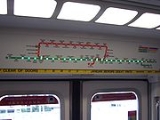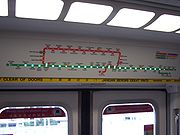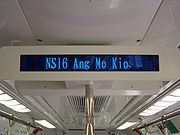
SMRT Active Route Map Information System
Encyclopedia
The SMRT Active Route Map Information System (STARIS) is a rail travel information system developed in house by communications engineers from SMRT Corporation
for its North South Line
and East West Line
trains in Singapore
. This system was officially announced on November 7, 2008 (although SMRT had revealed plans for such a system much earlier) and installed on trainset 053/054 on a 2 month trial. This was later extended to more trains from February 2009. An earlier version of the Active Route Map being tested had the North South Line and East West Line map on a black background and had an additional LED screen capable of displaying text. The text and station symbols were also not in the standard LTA font and design while the light indicating the side doors would open was a single small light. This has since been modified to the current version based on the LTA font, symbols and based on a white background with a separate VFD for displaying text located aside from the Active Route Map and 6 LED bulbs now indicate the side train doors open.
STARIS is expected to cost S$20,000 per carriage and S$12 million in total.

 STARIS comprises a system of 4 Vacuum Fluorescent Displays (VFD) mounted at an angle from the ceiling and 8 active route maps mounted above every door in each car. The VFDs indicate the train service's direction of travel, terminal station, side of doors opening, doors closing messages, current station, next station, interchange station and displays multi-language text synchronized with in-train audio announcements. The active route maps indicate the line of travel, direction of travel, side of doors opening, current station, next station, terminal station, interchange station and the corresponding line for interchange.
STARIS comprises a system of 4 Vacuum Fluorescent Displays (VFD) mounted at an angle from the ceiling and 8 active route maps mounted above every door in each car. The VFDs indicate the train service's direction of travel, terminal station, side of doors opening, doors closing messages, current station, next station, interchange station and displays multi-language text synchronized with in-train audio announcements. The active route maps indicate the line of travel, direction of travel, side of doors opening, current station, next station, terminal station, interchange station and the corresponding line for interchange.
The Active Route Maps have the following lighting scheme:
Messages displayed on the VFDs include:
An independent system of red LEDs mounted above every door but below the Active Route Maps flash when the doors are closing.
and Shenzhen's in that information about the location of the train is not based upon the signaling system. As such, there is no need for additional track side signaling equipment to be installed to transmit information about the location of the train to the active route maps etc. This also allows for easier installation, maintenance and removes the need to upgrade any Automatic Train Control (ATC) system. As such, it costs approximately 4 times less to install STARIS than its Hong Kong counterpart.
STARIS is based on the distance travelled by the train instead, which in turn triggers the display of related information in the active route maps and VFDs in each train.
"STARIS" also has been installed in one Sentosa Expresss train.
It has been noted that for a North South Line train commencing service at Ang Mo Kio Station and which crosses over to the East West Line at Jurong East Station before terminating service at Pasir Ris Station during the morning peak, the Active Route Map will only show one line at a time (for instance, the North South Line) even though service continues on to the East West Line.
For stations where train terminates, the "Doors opening this side" LEDs will not light up, with the disadvantage that it did not know which track will the train will stop and terminate.
SMRT Corporation
SMRT Corporation is a public transport operator incorporated on March 6, 2000, as a result of an industry overhaul to form multi-modal public-transport operators in Singapore. It is the second-largest public-transport company in Singapore after ComfortDelGro...
for its North South Line
North South MRT Line
The North South Line was the 1st Mass Rapid Transit line in Singapore. The line is currently 44 km long with 25 stations, and is operated by SMRT Corporation...
and East West Line
East West MRT Line
The East West Line was the 2nd Mass Rapid Transit line in Singapore. The line is currently 49.2 km long with 35 stations , making it the longest MRT line in Singapore. It takes about 63 minutes to travel from one end to the other...
trains in Singapore
Singapore
Singapore , officially the Republic of Singapore, is a Southeast Asian city-state off the southern tip of the Malay Peninsula, north of the equator. An island country made up of 63 islands, it is separated from Malaysia by the Straits of Johor to its north and from Indonesia's Riau Islands by the...
. This system was officially announced on November 7, 2008 (although SMRT had revealed plans for such a system much earlier) and installed on trainset 053/054 on a 2 month trial. This was later extended to more trains from February 2009. An earlier version of the Active Route Map being tested had the North South Line and East West Line map on a black background and had an additional LED screen capable of displaying text. The text and station symbols were also not in the standard LTA font and design while the light indicating the side doors would open was a single small light. This has since been modified to the current version based on the LTA font, symbols and based on a white background with a separate VFD for displaying text located aside from the Active Route Map and 6 LED bulbs now indicate the side train doors open.
STARIS is expected to cost S$20,000 per carriage and S$12 million in total.


The Active Route Maps have the following lighting scheme:
- Past stations: Not lit
- Next stations: Green static light
- Current station: Red static light
- Between stations: Red flashing light
- Doors opening this side: Green static light when train is in between stations, green flashing light when approaching and upon arrival at a station
- Doors not opening this side: Red static light
Messages displayed on the VFDs include:
- "NS27 Marina Bay"
- "This train service terminates at NS27 Marina Bay"
- "Next station NS27 Marina Bay"
- "DOORS OPENING >>>>"
- ">>> DOORS OPEN >>>"
- "DOORS ARE CLOSING"
- Any other message in relation to the audio message in trains
An independent system of red LEDs mounted above every door but below the Active Route Maps flash when the doors are closing.
Comparisons
STARIS differs from other rail travel information system like those found in Hong Kong's MTRMTR
Mass Transit Railway is the rapid transit railway system in Hong Kong. Originally opened in 1979, the system now includes 211.6 km of rail with 155 stations, including 86 railway stations and 69 light rail stops...
and Shenzhen's in that information about the location of the train is not based upon the signaling system. As such, there is no need for additional track side signaling equipment to be installed to transmit information about the location of the train to the active route maps etc. This also allows for easier installation, maintenance and removes the need to upgrade any Automatic Train Control (ATC) system. As such, it costs approximately 4 times less to install STARIS than its Hong Kong counterpart.
STARIS is based on the distance travelled by the train instead, which in turn triggers the display of related information in the active route maps and VFDs in each train.
Availability
"STARIS" has been operational on all 111 trains as of today (Including the 5 C151As on Service).These trains run exclusively only on the North South Line and East West Line."STARIS" also has been installed in one Sentosa Expresss train.
Operating condition
There have been reports of malfunctions with the STARIS. These include the display of the wrong station on the VFD or Active Route Maps, the wrong side at which the doors will open being indicated or in the worst case, random LEDs being lit up across the Active Route Maps.It has been noted that for a North South Line train commencing service at Ang Mo Kio Station and which crosses over to the East West Line at Jurong East Station before terminating service at Pasir Ris Station during the morning peak, the Active Route Map will only show one line at a time (for instance, the North South Line) even though service continues on to the East West Line.
For stations where train terminates, the "Doors opening this side" LEDs will not light up, with the disadvantage that it did not know which track will the train will stop and terminate.

